Up close and personal with George Washington
The United States One Dollar Bill. If you’re a yankee you may have seen one of these before. I decided to take a closer look, piece together research and give you an overly intimate view of the good ol’ buckaroo (minus the conspiracy theories). It's got a super neat picture of a guy that lived a long time ago, named George Washington.
To start on a light note, the official U.S. website for producing currency is http://www.moneyfactory.gov/. MONEY FACTORY!
Front
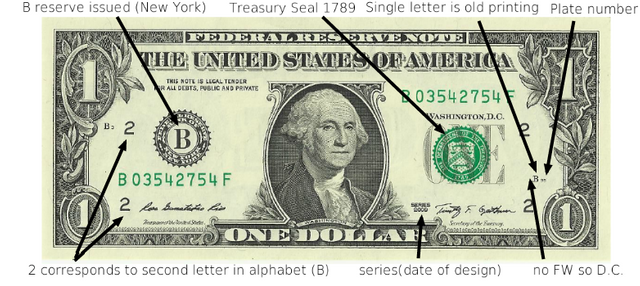
Details-
At the top it states it is a “FEDERAL RESERVE NOTE”, meaning it’s value is backed by the authority of the Federal Reserve. It also states “THIS NOTE IS LEGAL TENDER FOR ALL DEBTS, PUBLIC AND PRIVATE”. This statement basically forces anyone in the United States to consider “FEDERAL RESERVE NOTES” as being valuable. On the face of course is the mug shot of George Washington the first president of the United States. To the right of his face is the series, which indicates when the bill was designed, not printed. All notes are signed by the Treasurer of the United States and the Secretary of the Treasurer. The large B letter is surrounded by the name of the central bank which issued the bill and the letter represents the reserve where it was printed. There are 12 reserves in total that print money, Boston, New York, Philadelphia, Cleveland, Richmond, Atlanta, Chicago, Saint Louis, Minneapolis, Kansas City, Dallas, and San Francisco. The large B must correspond to the same letter in the serial number beginning with B. The serial number is printed in the bottom left and top right of the note. The number 2 is found four times on the note, and corresponds with the second letter of the alphabet. The small letters in the bottom right correspond to the location the bill was printed. If FW than Dallas Fort Worth, if no FW than Washing DC. The seal over the large ONE letters is the US Treasury seal from 1789 from its inauguration. The small letter in the bottom right corresponds to the US Mint’s printing information plate. Single letter means printed on a sheet of 12 or 18, and a letter and a number means a modern 32-position sheet.The small number following is the printing plate number.
Back
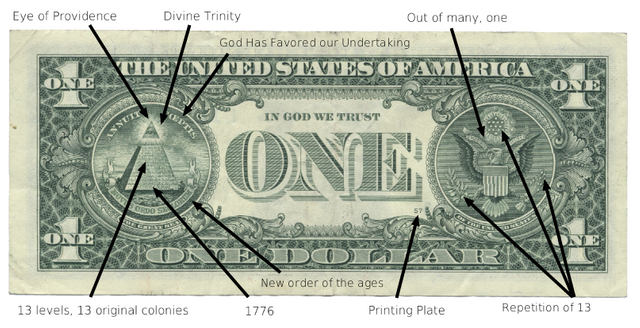
Details-
On the left side is a large circle with a pyramid. The words “ANUIT COEPTIS” above mean “God has favored our undertaking”. Below are the words, “NOVUS ORDO SECLORUM”, which means “New order of the ages.” According to the research of Richard S. Patterson and Richardson Dougall the origin is from a Roman poet named Virgil Annuit cœptis comes from the Aenid, book IX, line 625, which reads, Iuppiter omnipotens, audacibus adnue cœptis. It is a prayer by Ascanius, the son of the hero of the story, Aeneas, which translates to, "Jupiter Almighty, favour [my] bold undertakings", just before slaying an enemy warrior, Remulus. At the top of the triangle is The Eye of Providence, “All-seeing eye of God”, which is a symbol that dates back to Egyptian mythology. The Triangle represents divine trinity. The pyramid has 13 levels, 13 original colonies, unfinished, because the US was still building itself. On the base of the pyramid are the Roman Numerals, MDCCLXXVI which coordinate to 1776 the founding of the United States. Above the large letters “ONE” is "IN GOD WE TRUST”. This phrase first appeared on U.S. coins only in 1864. A law was passed in a Joint Resolution by the 84th Congress (P.L. 84-140) and approved by President Eisenhower which declared “IN GOD WE TRUST” must appear on U.S. currency. This law was proposed because of the Red Scare or threat of communism that the U.S. government perceived, and it was supposed to help solidify the American Moral compass. Below the large “ONE” to the right is the printing plate number. On the right side the latin “E PLURIBUS UNUM” is above the eagle meaning “Out of many, one”. Surrounding the eagle are repeated use of 13, for the 13 colonies. 13 stars, 13 olive branch leaves, 13 olives on branch, 13 arrows, 13 stripes on shield and the eagle is of course the official national symbol of the United States. Both circles are surrounded by “THE GREAT SEAL OF THE UNITED STATES”.
Brief History of Value
The federal reserve was created in 1913 to provide the nation with a safer, more flexible, and more stable monetary and financial system, as is seen in the following chart of devaluation..
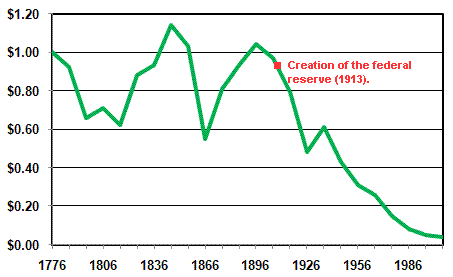
In order to deal with the great depression U.S. forced citizens to turn over their gold in 1933 for federal reserve notes.
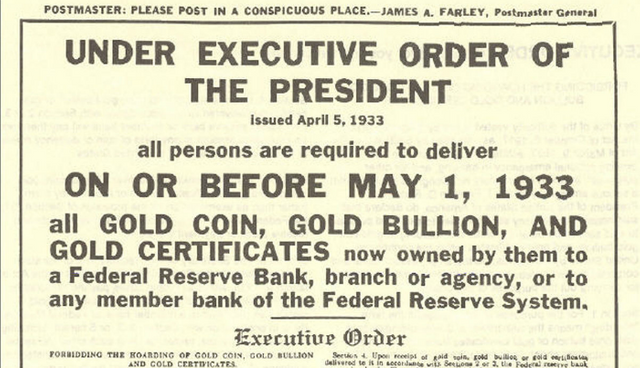
Until 1971 the us held $35 per ounce, then President Nixon decreed the United States would not convert dollars to gold at a fixed value. Thus ended the gold standard. So currently we’re basically running a fractional reserve banking system on steroids, where we print money lend it to ourselves I don't know my economics professor explained to me why it has to be this way, but I just went into cryptocurrencies.
Sources:
https://en.wikipedia.org/wiki/In_God_We_Trust
https://en.wikipedia.org/wiki/Annuit_c%C5%93ptis
http://www.moneyfactory.gov/uscurrency/howmoneyismade.html
[images creative commons]
" I don't know my economics professor explained to me why it has to be this way, but I just went into cryptocurrencies." <---- how bitcoin was born, someone said:
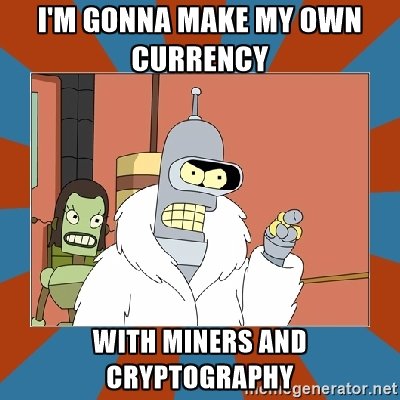
yea it's fun looking back. So basically the money is lent to the banks, which is then lent back to the government after their cut, which is then lent on the market to foreign countries, and this sustains our economy, because the people that own our debt know we'll always pay them back, and the value of our currency will be strong. Ohhhh ok, so you're saying if I ran a corner store like this, I'd go to jail? yes.
if you look deep enough the financial system is a big scam but it's working. yeeey
I spoke with a good friend of mine who worked previously at some large banks. I said, "are banks evil?", he said, "not exactly they literally will completely fail if they don't keep doing this, there is no changing the banks, they're stuck, big time, it has to come from the outside.", but there's some evil in there somewhere.
Thanks for sharing the information with us.
I'm glad you liked it, thank you.